![]()
ARMENIA: THE CRADLE OF CIVILIZATION
THE BEGINNING OF HUMAN CIVILIZATION

Written by Gevork Nazaryan
The recent sensational discoveries by a team from the German Archaeological Institute [the first findings were made in 1994 and are still ongoing], led by field director Dr. Klaus Schmidt and Harald Hauptmann -- at Göbekli Tepe [lit. navel Mountain], 15 km northeast of the city of Sanliurfa, near historic Urfa or Urha, the point of origin of the Armenian Solar cult of Orion that later spread to other parts of the globe, has been a truly revolutionary archaeological discovery. The cult site consists of circular stone formations that look similar to those in Stonehenge, only that Stonehenge is about 6,000 years younger.

A Y A - - T H
E M O T H
E R G O D D
E S S
S E A T E D B E T W E E N T W O L E O P A R D S A N D G
I V I N G B I R T H
S Y M B O L I C O F F E R T I L I T Y A N D
L I F E
'...At Ice Age's end, sociality would draw men and women into conformity chambers of unprecedented size. One byproduct would be conformity's antithesis - diversity - surging ideas at ferocious speed into the arteries of the inter-human brain. Old networks would give way to new, hastening the pace at which the fuel of concepts from afar would kindle flares of fire in the furnace of mass mind...'
from -- 'The End of the Ice Age and the Rise of Urban Fire'
The first human settlements took place around the cities of Urfa [ancient Armenian Ur-hay] and modern day Diyarbakir [near the ruins of Tigranakert] in the historic Alznik province of Armenia. Excavations at one of these sites, Nevali Çori, revealed clues that the Neolithic Age had started between 12,000 and 10,000 B.C. in this area, at least 500 years earlier than at Çatal Hüyük and Hacilar. The temple architecture found here gives important clues about the beliefs of the first Civilization builder settlers, as well as for their time period very sophisticated architectural techniques. Their use of T -shaped pillars showed an advanced knowledge of how to build strong, load-bearing structures. Göbekli Tepe, shows similarities with Nevali Çori and provides support that earlier advancements in human life had taken place in the Armenian Plateau and its immediate vicinity. Rooms excavated at the site have revealed stone pillars decorated with floral and faunal reliefs. It was here at Göbekli Tepe where some of our hunter-gatherer ancestors [who were just starting to settle down and organize into societies] first created sophisticated art for ritual purposes.
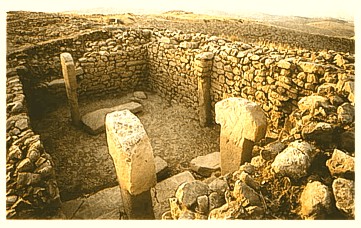
GÖBEKLI TEPE. THE REMNANTS OF
THE T-SHAPED PILLARS THAT
SUPPORTED THE MAIN SANCTUARY OF THE TEMPLE.
THE PILLARS ARE ADORNED WITH LION RELIEFS.
An ancient place of worship, Göbekli Tepe was a very important cult site carbon-dated to the second half of the 9th millennium BC [the finds have been published in the prestigious scientific magazine Bild Der Wissenschaft entitled -- 6,000 Years before the Pyramids! describing the world's oldest temple located in Armenian Plateau and dated to circa 9,000 BC -- or 11,000 years ago! thus making it older than the renowned city of Çatal Hüyük. Göbekli Tepe reflects what the experts say is the place of the Neolithic Revolution, a turning point from the earlier hunter and gatherers Epipaleolithic era to that of the Early Neolithic era [of first settlements] in Armenian Plateau and upper Mesopotamia. At the entrance of the historic site stand four megalithic limestone pillars, 7 meters tall and weighing perhaps 50 tons each. Two of them bear the image of a snarling lion defending what Hauptmann believes to be a cult sanctuary or shrine. Erected without the aid of domesticated animals 6,000 years before giant structures were built in Pharaonic Egypt, the pillars suggest that early Neolithic workers knew how to use poles, boards and pulleys to handle huge stones. Hauptmann's site also features a unique floor relief of a squatting woman [one of the early depictions of AYA -- the Mother Goddess] -- perhaps giving birth-- reliefs of a variety of animals, and a field of flint chips, indicating the site also hosted a fairly sophisticated tool- and weapon-producing operation.
| GÖBEKLI TEPE (37º 13' N, 38º
55' E) References: (1) Kromer and Schmidt 1998:8; (2) Pustovoytov 2002. |
|||||
| Lab. no. | Date BP | Cal BC 1σ | Sample material | Lvl. | Provenance |
| Hd-20036 | 9559±53 | 9130-8790 | charcoal, Pistacia sp., Amygdalus sp. | III | structure A (Schlangen-pfeilergebäude), fill, area L9-75, locus 48.1 (1) |
| Hd-20025 | 9452±73 | 9110-8610 | charcoal, Pistacia sp., Amygdalus sp. | III | structure A (Schlangen-pfeilergebäude), fill, area L9-75, locus 44.3 (1) |
| Ua-19562 | 8960±85 | 8270-7970 | pedogenic carbonate coating | structure B, pillar 8, 105 cm below surface, lime sinter on pillar, area L9-66 (2) | |
| Ua-19561 | 8430±80 | 7590-7370 | pedogenic carbonate coating | structure C, pillar 11, 115 cm below surface, lime sinter on pillar, area L9-76 (2) | |
THE CARBON DATING SHEET OF
GÖBEKLI TEPE
MADE AT LABS:
HD- 20036, HD20025, UA-19562, UA-19561.
A rich collection of small limestone sculptures and clay figures was found at Nevali Çori, as well as life-size limestone figures, providing for the first time an idea of how people in the area worshiped 8,000 years before the birth of Christ. The larger work is animistic, some of it featuring humans and animals in carvings resembling totem poles. The masterpiece of the site is a sculpture of a female head grasped in the talons of a bird. Another sculpture depicts a male, head shaved in the fashion of ancient Armenic high priests, with a snake [symbolic of Wisdom] positioned at the back like a braid.
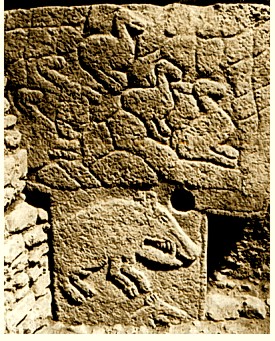
GÖBEKLI TEPE. RELIEF OF DUCKS
[UPPER SECTION] AND WILD BOARS
[LOWER SECTION] ON ONE OF THE COLUMNS OF THE TEMPLE.
THE FINE MARKSMANSHIP IN THE EXECUTION OF THE
RELIEFS --CONSIDERING THE TIME PERIOD-- IS ASTONISHING.
The archaeological team is working to understand the pre-pottery society that existed in this area some 10,000 years ago, says Angela von den Driesch, a professor of zoology at Munich University, and "to determine the exact moment of the transition from hunter-gatherer to agriculturalist." What prompted these ancient people to spearhead mankind's first revolution--the so-called Neolithic miracle--turning from the upland forests that had long provided sustenance to the very beginnings of lowland settlement and agriculture, the domestication of plants and animals? "Humans always react to problems and catastrophic events," says von den Driesch. "They are survivors, and adversity is usually a catalyst for change." Perhaps, she suggests, climatic shifts at the time gave them no choice.
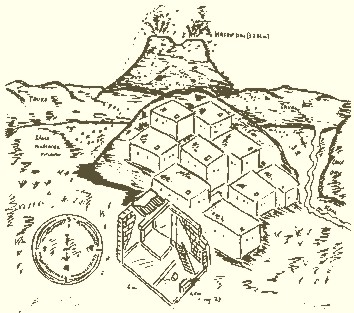
ÇATAL HÜYÜK
WAS BUILT IMMEDIATELY IN THE VALLEY OF THE TWIN MOUNTAIN
"In this kind of work," says Hauptmann, "we come nearer the people before us. The art helps, and the sculpture." Gazing at the field of flint at Göbekli Tepe -- and looking back 10,000 years--the German scientist notes the dryness of the surface stone and its unsuitability for tool making. The ancient hunter-gatherers, he postulates, probably mined flint containing water from the limestone bedrock, then heated it to make their tools. This, Hauptmann adds, was quite a sophisticated technique. "In this period, mankind learned to deal with different materials for the first time. It was a real revolution in technology -- a step forward, a step to new ways of life." As early as 7000 BC, Neolithic artisans in the Armenian Highland were able to drill deep holes in agate beads over 5 centimeters in length. Necklaces and beads have been found at various archaeological sites such as Nevali Çori that clearly display this remarkable quality. Today we need a diamond-tipped, tungsten carbide drill to do the same job!

RECONSTRUCTION SKETCH OF
ÇATAL HÜYÜK.
ARIAL VIEW.
The most troubling aspect to all of this is the fact that many priceless monuments at these sensational sites are being destroyed by the negligence and even more so the sheer lack of proper understanding of their global significance by the Turkish government. The Turkish government is harnessing the power of the Euphrates river, and its Mesopotamian sister, the Tigris, in the massive 22-dam Southeast Anatolia Project (G.A.P. or Güneydoğu Anadolu Projesi). The artificially created lakes have destroyed some archaeological sites and barely explored ancient cities. Among those gone is Samosata, along the upper Euphrates. It now lies under 120 meters of water trapped behind the huge "Ataturk Dam" 20 km downriver. Nevali Çori was submerged a year later by "the Ataturk project."
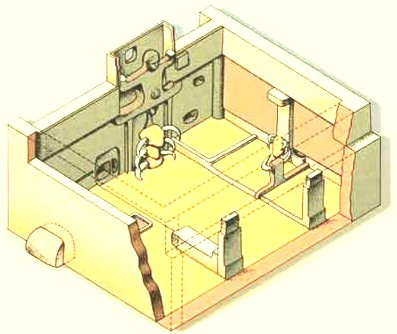
RECONSTRUCTION OF THE TEMPLE OF
THE MOTHER GODDESS AT
ÇATAL HÜYÜK
THE ENTRY IS GUARDED BY TWO PILLARS
[SYMBOLIC OF THE LAND OF THE TWIN MOUNTAIN]
AND THE ALTAR IS ADORNED WITH THREE BULL
HEADS STACKED ONE UPON ANOTHER
[SYMBOLIC OF THE TRIPLE DECKER UNIVERSE]
AYA IS ABOVE IN A SYMBOLIC POSITION OF GIVING BIRTH
TO THE COSMIC MATRIX
Some 100 km farther down the
Euphrates and about 60 km east of the city of Gazientep [historic Aintab of
Cilician Armenia], the Birecik Dam is under construction. When the dam
eventually goes into operation, it will drown Zeugma under a 40 meter deep lake.
With it will vanish a nearby early Bronze Age burial site, on the right bank of
the Euphrates, that France's Abadie-Reynal says is "probably the richest
necropolis in the whole area." A team from the Gazientep Museum excavated 400
limestone tombs, recovering not just bones but jewelry, vases and other objects.
Abadie-Reynal believes there could be as many as 3,000 tombs at the
5,000-year-old site. No one will ever know for sure. A construction crane has
clawed at the arid ground, now off-limits to archaeologists, loosening earth
that has been hauled away to help fill the Birecik Dam. What of the tombs? "The
stones will stay and be submerged," says Abadie-Reynal.

THE FIRST SETTLED CIVILIZATION BUILDERS OF AR-MEN-IC EXTRACTION
CARRIED THE BULL CULT [SYMBOL OF FEMININE FERTILITY]
TO OTHER PARTS OF THE ANCIENT WORLD
BEGINNING IN THE NEAR EAST INCLUDING EGYPT WHERE
THE EXCAVATED REMNANTS OF THE SAQARRA TOMB OF THE PHARAOH UADJI
OF THE 2ND DYNASTY [2770 - 2650 BC] WERE FOUND TO BE
VIRTUALLY IDENTICAL TO THAT OF
ÇATAL HÜYÜK
SHRINES
Studies conducted by Melinda A Zeder and Brian Hesse (Science 287 (2000) 2254-57) place the initial domestication of goats to the Zargos Mountains at about 10,000 years ago. And Manfred Heun's (Science 278 (1997) 1312-14) studies indicate that large scale wheat cultivation began from 8,000 to 9,000 years ago near the Karacadag Mountains. Both areas are very near where the Tigris and Euphrates Rivers originate n the highlands of Armenia. Simcha Lev-Yadun of Israel's Agricultural Research Organization and his colleagues have also come to the conclusion that the first farms were located in Armenia.

A BLUE EYED STATUE FROM THE EARLIEST EGYPTIAN DYNASTIES
A BUST OF AN EGYPTIAN NOBLE LADY FROM THE FOURTH DYNASTY [CIRCA 2600] BC.
A STRIKINGLY LIFELIKE FIGURE SHOWING THE TRADEMARK AR-MEN-IC FEATURES
INLAID WITH LAPIS LAZULI [RADIANT BLUE PRECIOUS GEMSTONE].
It is known that agriculture spread from the Armenian Plateau and adjoining areas of the Fertile Crescent to Europe during the Neolithic period about 12,000 years ago. Was it due to the movement of people or to the movement of ideas? Previous genetic analysis of people living today suggests a migration -- that the people moved. The latest study reinforces evidence of a migration in which people brought their ideas and lifestyle with them. The humans of the 'Garden of Eden' as was held in the collective consciousness of the ancients, had the capability, with their advanced technology to dominate over all other living creatures on the earth, a capability fully demonstrated only by the migrants out of the Land of Ararat as they developed their methods of farming, animal domestication and community building. The settler cultivator -- civilization builders -- the biblically speaking 'Adam and Eve' were farmers and not hunter-gatherers.
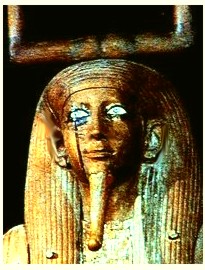
THE STATUE OF THE PHARAOH HOR [FIRE] CIRCA 1783-1633 BC
NOTICE THE HORNS THAT AT THEIR TIPS FORM THE
LEFT AND RIGHT HANDS [SYMBOLIC OF THE BULL CULT]
THE EYES OF THE STATUE --INLAID IN LAPIS LAZULI --
SHINE WITH THEIR CRYSTAL BLUE BRIGHT EYES.